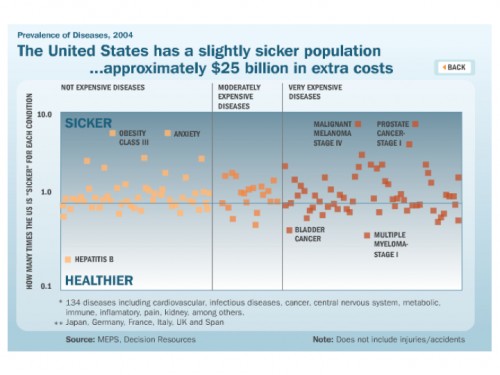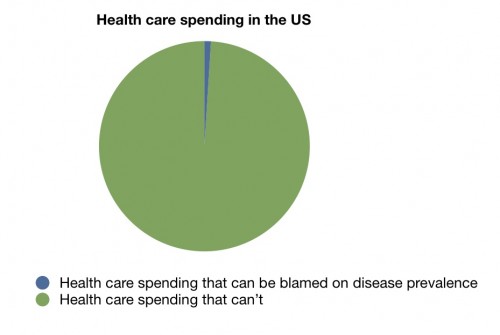This is an ongoing series on health care system “memes” that continue to permeate our debate, even when evidence shows them to be false. The introductory post contains links to all entries.
Every time I read some article on how this disease, or that condition, is driving our health care costs, I sigh. If only it were so. That would make things so much easier. Especially, if the condition were something like obesity. Then, we could blame our health care costs on personal behavior or something out of our control. Are our high health care costs due to disease or condition prevalence?
As is often the case, this is an answerable question. McKinsey & Company answered it in their study, Accounting for the cost of health care in the United States:
First they figured out the relative prevalence of 134 disease states between the US and six other countries (Japan, Germany, France, Italy, UK, and Spain). Then they figured out how expensive these disease states were to treat. Knowing the relative costs, and the relative prevalences, they determined how much more we could expect to spend compared to other countries because of the prevalences of disease.
Let me orient you to this chart. Diseases which are more prevalent in the US relative to other countries are shown above the horizontal line. Diseases that are more expensive to treat are towards the right. So, Multiple Myeloma (bottom right) is less common in the US and expensive. That should help out our overall costs. Hepatitis B (lower left) is less common in the US, but relatively cheap to treat, so it doesn’t help us out much.
Obesity (upper left) is common, but not that expensive, either. It’s not driving our costs. Yes, it can lead to other health care problems, but those are accounted for in the 133 other disease states. And, using math, you can figure out how much diseases and conditions impact costs here in the US.
See, the thing is, we only read articles about diseases and conditions that are more common in the US. We never hear about those that are rare. You can’t cherry pick, though. Some things will be more prevalent here, and some things less; what matters is the aggregate.
So what did McKinsey and Company find? Disease prevalences account for perhaps an extra $25 billion in health care spending. Let me make a new chart for you:
It’s comforting to some to believe that we have no control over our costs. If that were so, and we could blame our costs on the fact that we have more of this cancer or too many obese people or much more heart disease than other countries, then it wouldn’t be our fault. But it’s just not true. There is no simple fix here. There is no one, and no thing, we can easily blame.



